Differences of Cycling Experiences and Perceptions between E-Bike and Bicycle Users in the United States
Abstract
:1. Introduction
2. Background
2.1. E-Bike
2.2. North American E-Bike Users
3. Method
3.1. Data Collection
3.2. Ordinal Logit Model of Interest in E-Bike Purchase in the Future
4. Results
4.1. Demographics
4.2. Bicycles and E-Bike Use
4.2.1. Cycling Experience
4.2.2. Motives and Perception for E-Bike Use
4.2.3. Expectation of E-Bikes
4.3. Model Result
5. Discussion and Conclusions
Acknowledgments
Author Contributions
Conflicts of Interest
References
- MacArthur, J.; Dill, J.; Person, M. Electric bikes in the North America: Results of an online survey. Transp. Res. Rec. J. Transp. Res. Board 2014, 2468, 123–130. [Google Scholar] [CrossRef]
- Yang, C.-W.; Ho, Y.-L. Assessing carbon reduction effects toward the mode shift of green transportation system. J. Adv. Transp. 2016, 50, 669–682. [Google Scholar] [CrossRef]
- Sun, Y.; Mobasheri, A.; Hu, X.; Wang, W. Investigating Impacts of Environmental Factors on the Cycling Behavior of Bicycle-Sharing Users. Sustainability 2017, 9, 1060. [Google Scholar] [CrossRef]
- Citron, R.J.G. Electric Bicycles: Li-Ion and SLA E-Bikes: Drivetrain, Motor, and Battery Technology Trends, Competitive Landscape, and Global Market Forecasts; Navigant Research: Boulder, CO, USA, 2016. [Google Scholar]
- Ling, Z.; Cherry, C.R.; Yang, H.; Jones, L.R. From e-bike to car: A study on factors influencing motorization of e-bike users across China. Transp. Res. Part D Transp. Environ. 2015, 41, 50–63. [Google Scholar] [CrossRef]
- Fishman, E.; Cherry, C. E-bikes in the Mainstream: Reviewing a Decade of Research. Transp. Rev. 2016, 36, 72–91. [Google Scholar] [CrossRef]
- Cherry, C.R.; Yang, H.; Jones, L.R.; He, M. Dynamics of electric bike ownership and use in Kunming, China. Transp. Policy 2016, 45, 127–135. [Google Scholar] [CrossRef]
- Jamerson, F.; Benjamin, E. Electric Bikes Worldwide Reports—Revealing the Revolution in Two Wheel Mobility. 2015. Available online: http://www.ebwr.com/ (accessed on 18 September 2017).
- Jamerson, F.; Benjamin, E. Electric Bikes Worldwide Reports—Light Electric Vehicles/EV Technology. 2013. Available online: http://www.ebwr.com/ (accessed on 18 September 2017).
- Cherry, C.; Cervero, R. Use characteristics and mode choice behavior of electric bike users in China. Transp. Policy 2007, 14, 247–257. [Google Scholar] [CrossRef]
- Weinert, J.; Ma, C.; Yang, X.; Cherry, C. Electric Two-Wheelers in China: Effect on Travel Behavior, Mode Shift, and User Safety Perceptions in a Medium-Sized City. Transp. Res. Rec. J. Transp. Res. Board 2007, 2038, 62–68. [Google Scholar] [CrossRef]
- Jones, T.; Harms, L.; Heinen, E. Motives, perceptions and experiences of electric bicycle owners and implications for health, wellbeing and mobility. J. Transp. Geogr. 2016, 53, 41–49. [Google Scholar] [CrossRef]
- Popovich, N.; Gordon, E.; Shao, Z.; Xing, Y.; Wang, Y.; Handy, S. Experiences of electric bicycle users in the Sacramento, California area. Travel Behav. Soc. 2014, 1, 37–44. [Google Scholar] [CrossRef]
- Johnson, M.; Rose, G. Extending life on the bike: Electric bike use by older Australians. J. Transp. Health 2015, 2, 276–283. [Google Scholar] [CrossRef]
- Langford, B.C.; Chen, J.; Cherry, C.R. Risky riding: Naturalistic methods comparing safety behavior from conventional bicycle riders and electric bike riders. Accid. Anal. Prev. 2015, 82, 220–226. [Google Scholar] [CrossRef] [PubMed]
- Weber, T.; Scaramuzza, G.; Schmitt, K.U. Evaluation of e-bike accidents in Switzerland. Accid. Anal. Prev. 2014, 73, 47–52. [Google Scholar] [CrossRef] [PubMed]
- Langford, B.C.; Cherry, C.R.; Bassett, D.R.; Fitzhugh, E.C.; Dhakal, N. Comparing physical activity of pedal-assist electric bikes with walking and conventional bicycles. J. Transp. Health 2017, in press. [Google Scholar] [CrossRef]
- MacArthur, J.; Kobel, N. Evaluation of an Electric Bike Pilot Project at Three Employment Campuses in Portland, Oregon. In Proceedings of the Transportation Research Board 95th Annual Meeting, Washington, DC, USA, 10–14 January 2016. [Google Scholar]
- Dill, J.; Rose, G. Electric bikes and transportation policy: Insights from early adopters. Transp. Res. Rec. J. Transp. Res. Board 2012, 2314, 1–6. [Google Scholar] [CrossRef]
- Langford, B.; Cherry, C.; Yoon, T.; Worley, S.; Smith, D. North America’s First E-Bikeshare. Transp. Res. Rec. J. Transp. Res. Board 2013, 2387, 120–128. [Google Scholar] [CrossRef]
- Rose, G. E-bikes and urban transportation: Emerging issues and unresolved questions. Transportation 2012, 39, 81–96. [Google Scholar] [CrossRef]
- Fyhri, A.; Heinen, E.; Fearnley, N.; Sundfør, H.B. A push to cycling—Exploring the e-bike’s role in overcoming barriers to bicycle use with a survey and an intervention study. Int. J. Sustain. Transp. 2017, 11, 681–695. [Google Scholar] [CrossRef]
- Gojanovic, B.; Welker, J.; Iglesias, K.; Daucourt, C.; Gremion, G. Electric bicycles as a new active transportation modality to promote health. Med. Sci. Sports Exerc. 2011, 43, 2204–2210. [Google Scholar] [CrossRef] [PubMed]
- Louis, J.; Brisswalter, J.; Morio, C.; Barla, C.; Temprado, J.-J. The electrically assisted bicycle: An alternative way to promote physical activity. Am. J. Phys. Med. Rehabil. 2012, 91, 931–940. [Google Scholar] [CrossRef] [PubMed]
- Thomas, A. A More Sustainable Minivan? An Exploratory Study of Electric Bicycle Use by San Francisco Bay Area Families. In Proceedings of the Transportation Research Board 95th Annual Meeting, Washington, DC, USA, 10–14 January 2016. [Google Scholar]
- Fyhri, A.; Fearnley, N. Effects of e-bikes on bicycle use and mode share. Transp. Res. Part D Transp. Environ. 2015, 36, 45–52. [Google Scholar] [CrossRef]
- Wolf, A.; Seebauer, S. Technology adoption of electric bicycles: A survey among early adopters. Transp. Res. Part A Policy Pract. 2014, 69, 196–211. [Google Scholar] [CrossRef]
- Du, W.; Yang, J.; Powis, B.; Zheng, X.; Ozanne-Smith, J.; Bilston, L.; Wu, M. Understanding on-road practices of electric bike riders: An observational study in a developed city of China. Accid. Anal. Prev. 2013, 59, 319–326. [Google Scholar] [CrossRef] [PubMed]
- Yao, L.; Wu, C. Traffic Safety for Electric Bike Riders in China. Transp. Res. Rec. J. Transp. Res. Board 2012, 2314, 49–56. [Google Scholar] [CrossRef]
- Hu, F.; Lv, D.; Zhu, J.; Fang, J. Related Risk Factors for Injury Severity of E-bike and Bicycle Crashes in Hefei. Traffic Inj. Prev. 2014, 15, 319–323. [Google Scholar] [CrossRef] [PubMed]
- Schepers, J.P.; Fishman, E.; Den Hertog, P.; Wolt, K.K.; Schwab, A.L. The safety of electrically assisted bicycles compared to classic bicycles. Accid. Anal. Prev. 2014, 73, 174–180. [Google Scholar] [CrossRef] [PubMed]
- Papoutsi, S.; Martinolli, L.; Braun, C.T.; Exadaktylos, A.K. E-Bike Injuries: Experience from an Urban Emergency Department: A Retrospective Study from Switzerland. Emerg. Med. Int. 2014, 2014, 850236. [Google Scholar] [CrossRef] [PubMed]
- Campbell, A.A.; Cherry, C.R.; Ryerson, M.S.; Yang, X. Factors influencing the choice of shared bicycles and shared electric bikes in Beijing. Transp. Res. Part C Emerg. Technol. 2016, 67, 399–414. [Google Scholar] [CrossRef]
- Ji, S.; Cherry, C.R.; J. Bechle, M.; Wu, Y.; Marshall, J.D. Electric Vehicles in China: Emissions and Health Impacts. Environ. Sci. Technol. 2012, 46, 2018–2024. [Google Scholar] [CrossRef] [PubMed]
- MacArthur, J.; Kobel, N.; Dill, J.; Mumuni, Z. Evaluation of an Electric Bike Pilot Project at Three Employment Campuses in Portland, Oregon; National Institute for Transportation and Communities (NITC): Portland, OR, USA, 2016; Available online: http://pdxscholar.library.pdx.edu/trec_reports/125/ (accessed on 18 September 2017).
- Washington, S.P.; Karlaftis, M.G.; Mannering, F.L. Statistical and Econometric Methods for Transportation Data Analysis; CRC Press: Boca Raton, FL, USA, 2011. [Google Scholar]
- Williams, R. Gologit2: A Program for Generalized Logistic Regression/Partial Proportional Odds Models for Ordinal Variables. 2005. Available online: http://www.nd.edu/~rwilliam/stata/gologit2.pdf (accessed on 5 May 2017).
- McCullagh, P. Regression models for ordinal data. J. R. Stat. Soc. Ser. B 1980, 42, 109–142. [Google Scholar]
- Pucher, J.; Buehler, R.; Seinen, M. Bicycling renaissance in North America? An update and re-appraisal of cycling trends and policies. Transp. Res. Part A Policy Pract. 2011, 45, 451–475. [Google Scholar] [CrossRef]
- Moritz, W. Survey of North American Bicycle Commuters: Design and Aggregate Results. Transp. Res. Rec. J. Transp. Res. Board 1997, 1578, 91–101. [Google Scholar] [CrossRef]
- Garikapati, V.M.; Pendyala, R.M.; Morris, E.A.; Mokhtarian, P.L.; Mcdonald, N. Activity patterns, time use, and travel of millennials: A generation in transition? Transp. Rev. 2016, 36, 558–584. [Google Scholar] [CrossRef]
- Ryan, R.M.; Deci, E.L. Self-determination theory and the facilitation of intrinsic motivation, social development, and well-being. Am. Psychol. 2000, 55, 68–78. [Google Scholar] [CrossRef] [PubMed]
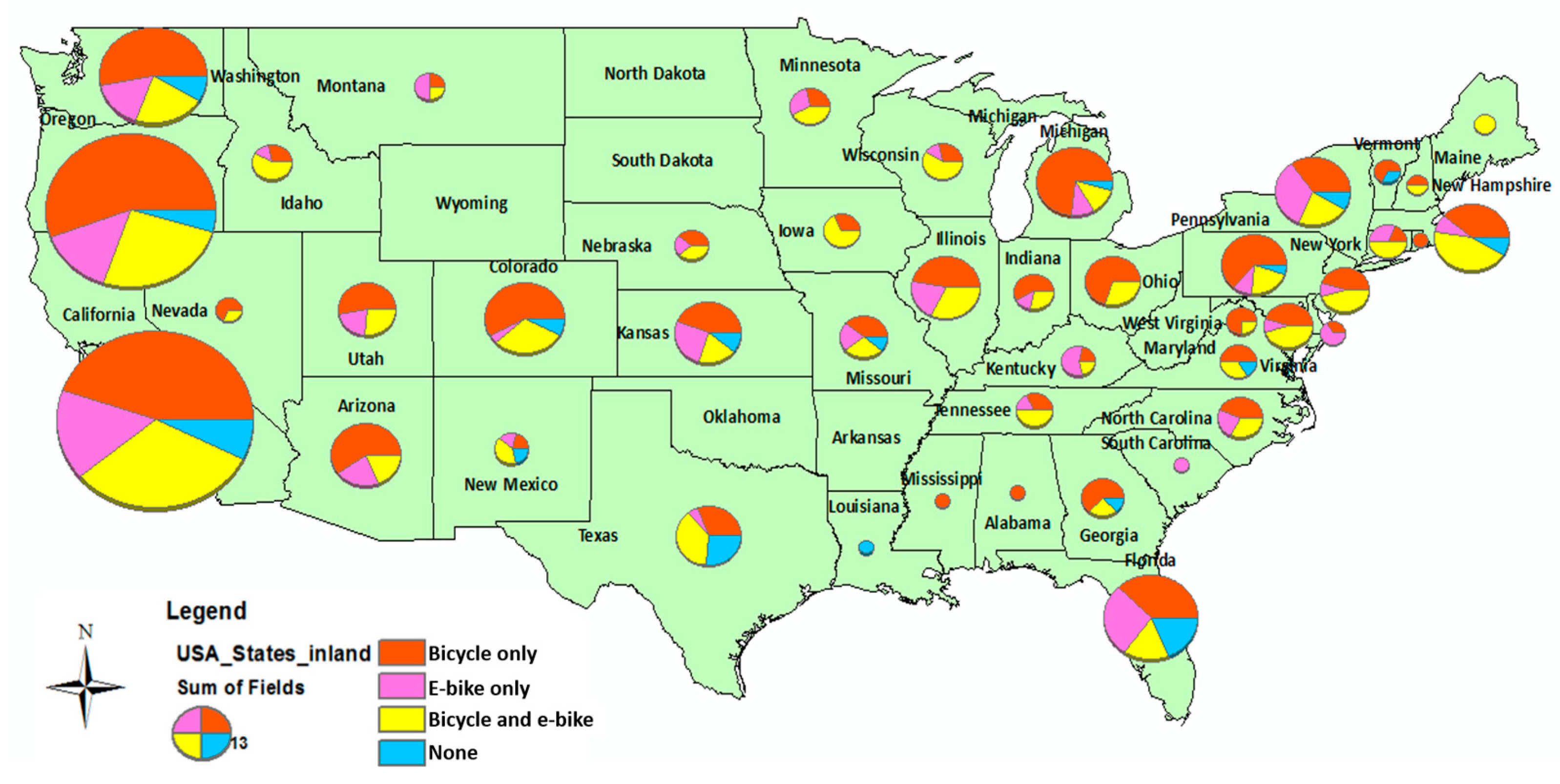
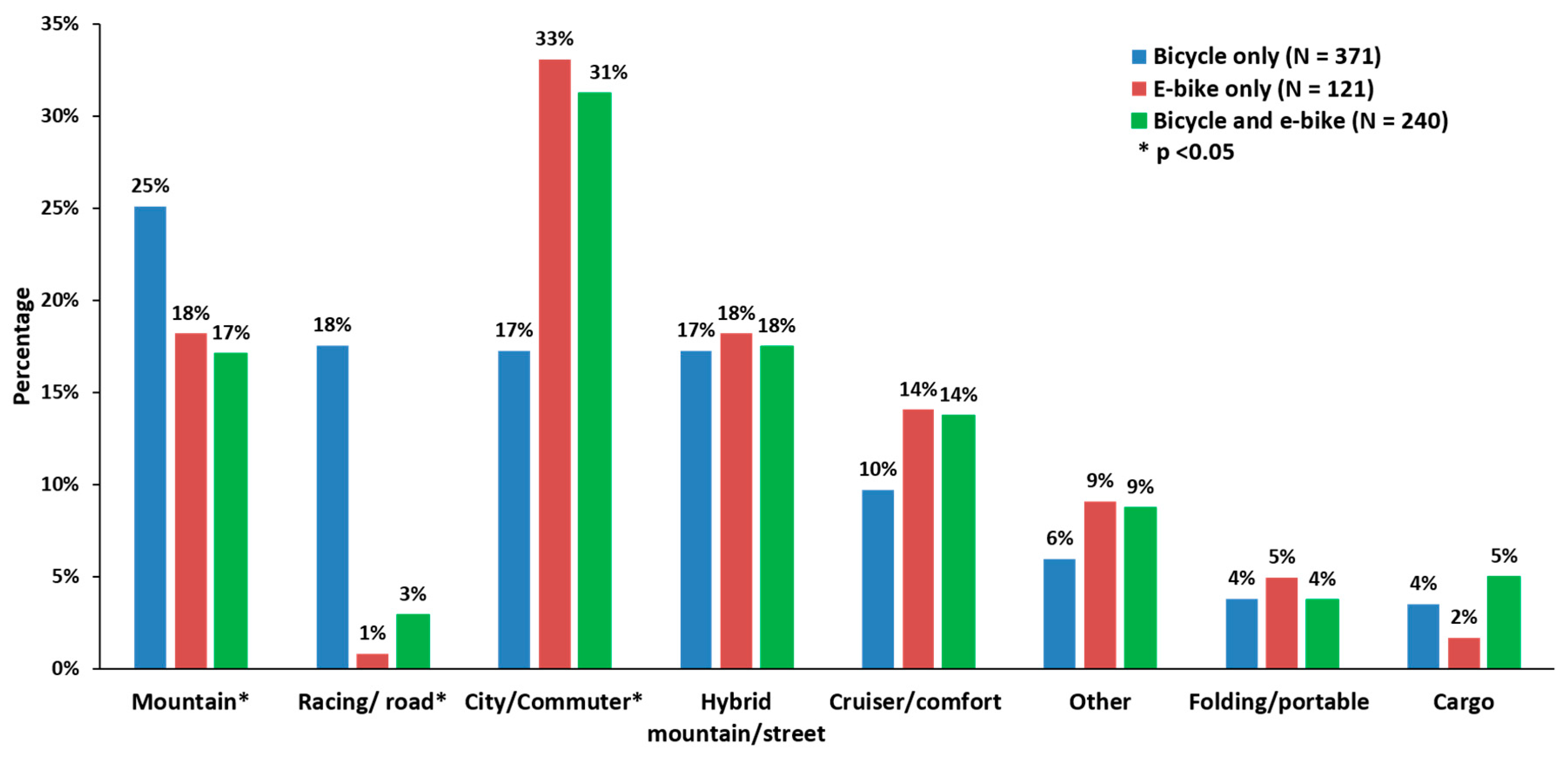
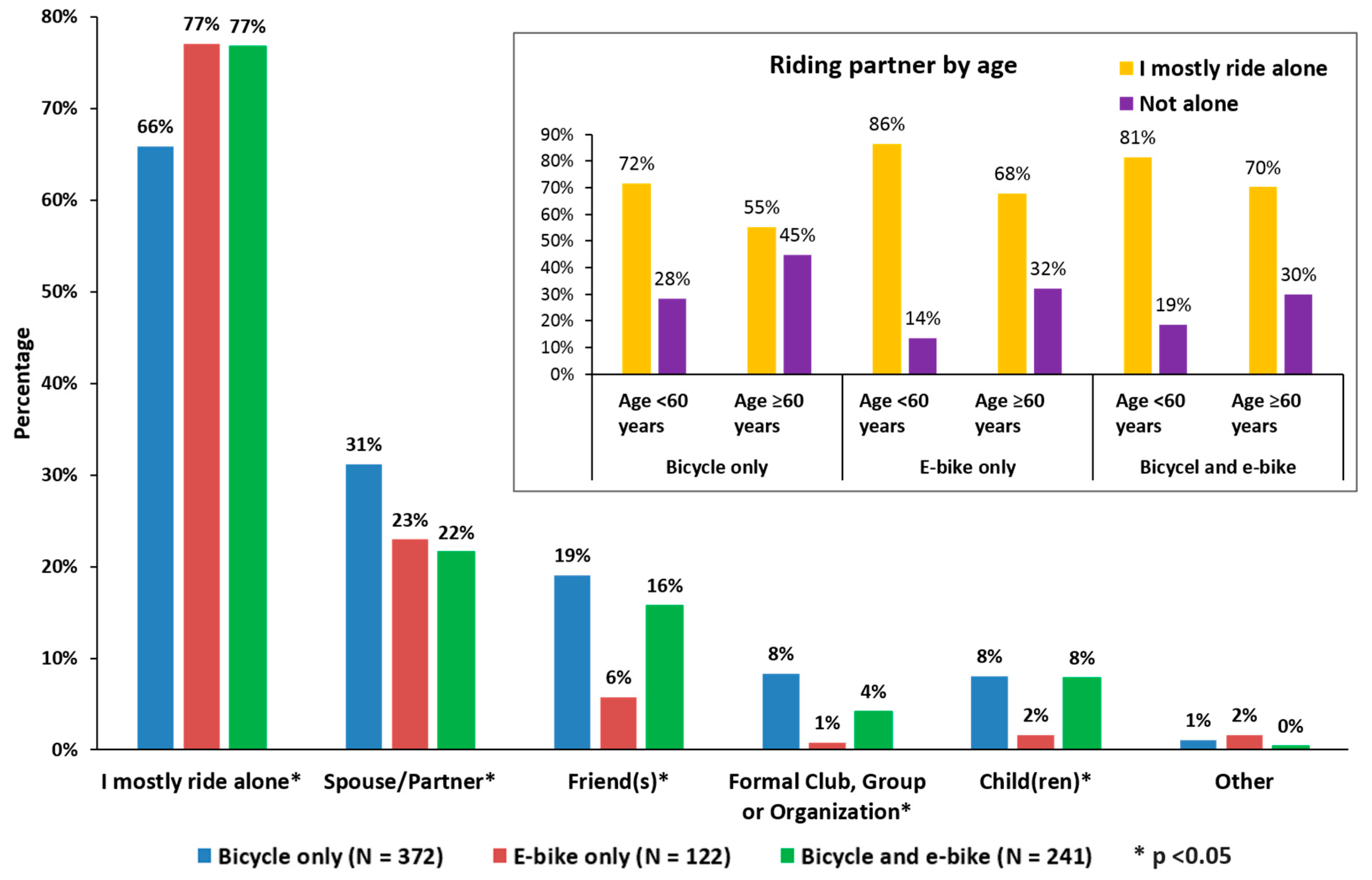
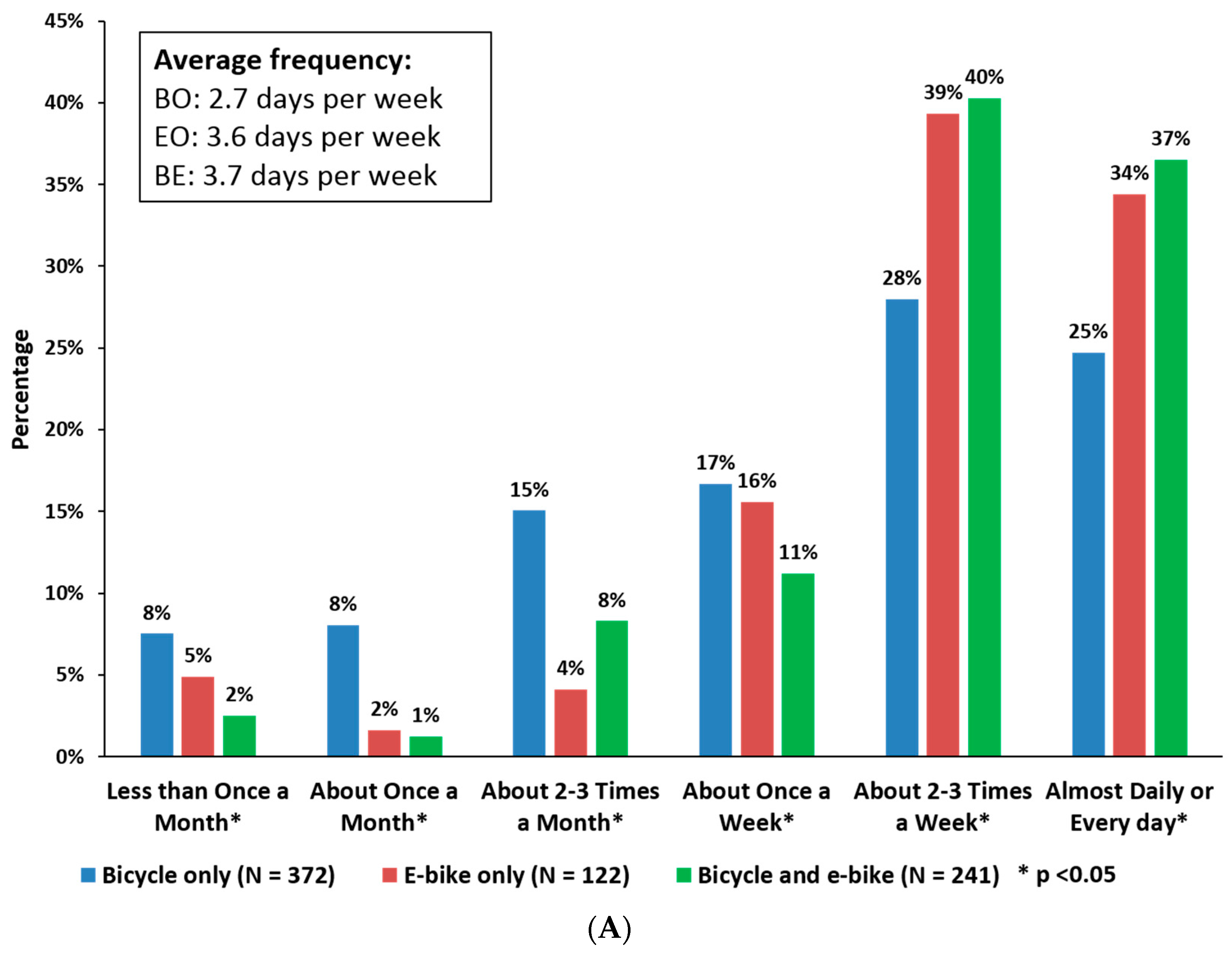
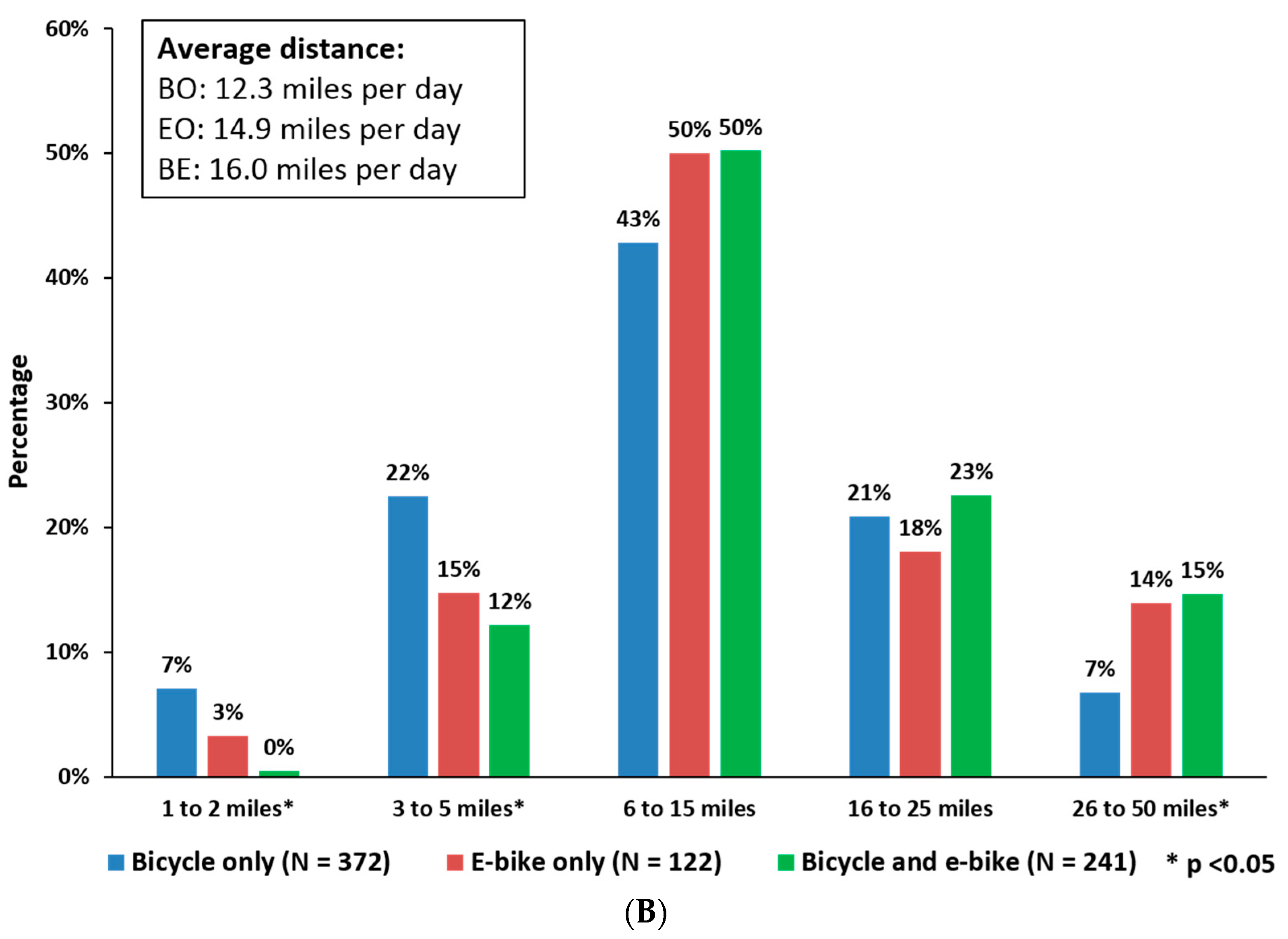
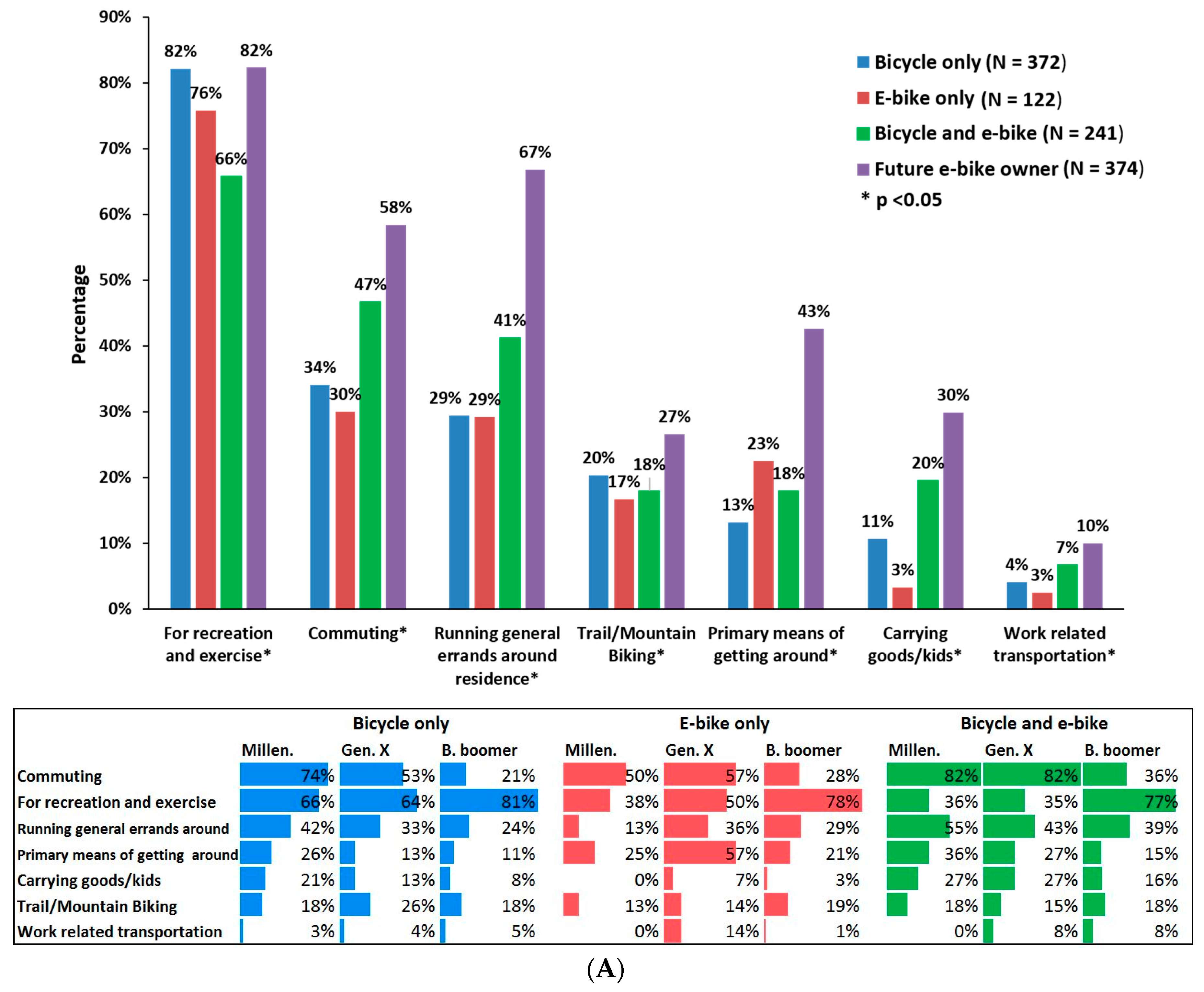
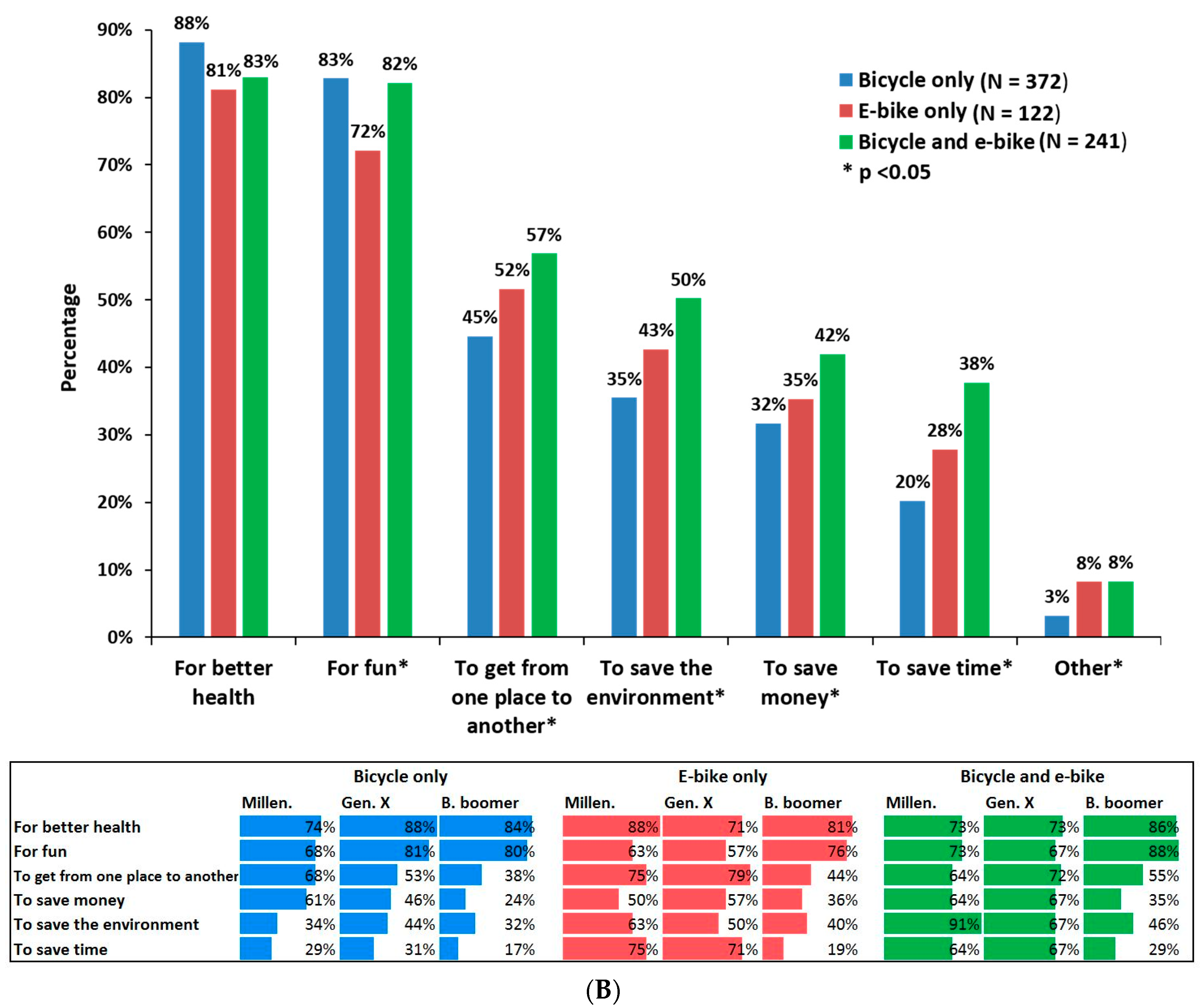
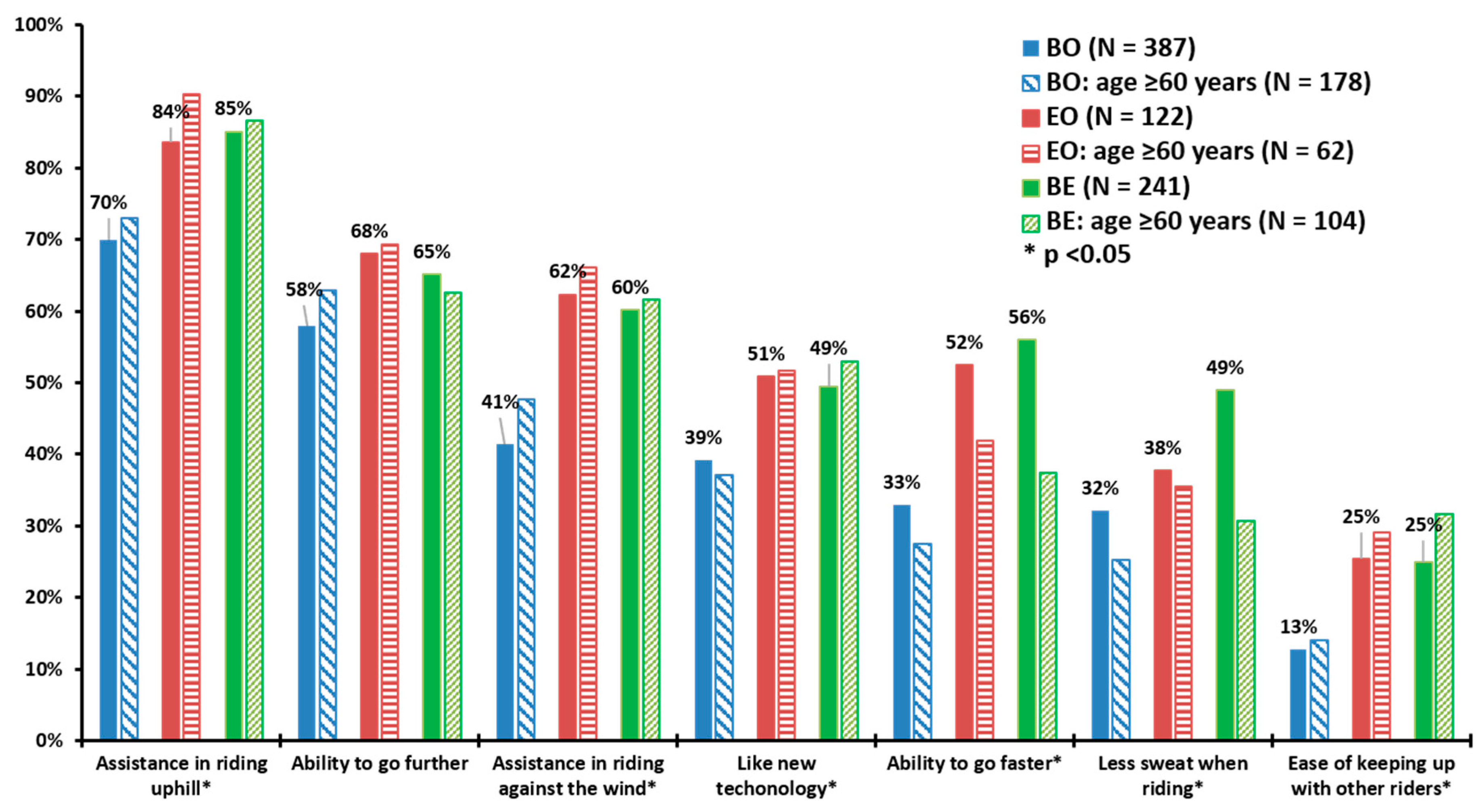
| Survey Component | Factors |
|---|---|
| Cycling experience |
|
| Motives and perception for e-bike |
|
| Expectation of future e-bikes |
|
| Bike purchase |
|
| Demographics |
|
| Total | Bicycle Only (BO) | E-Bike Only (EO) | Bicycle and E-Bike (BE) | |||||
|---|---|---|---|---|---|---|---|---|
| Variables | Value | % | Value | % | Value | % | Value | % |
| Gender | ||||||||
| Male | 622 | 83% | 323 | 83% | 98 | 80% | 201 | 83% |
| Female | 128 | 17% | 64 | 17% | 24 | 20% | 40 | 17% |
| Age | ||||||||
| Under 18 | 2 | 0% | 1 | 0% | 0 | 0.0% | 1 | 0% |
| 18 to 34 | 55 | 7% | 37 | 10% | 8 | 7% | 10 | 4% |
| 35 to 49 * | 152 | 21% | 78 | 21% | 14 | 12% | 60 | 25% |
| 50 to 69 | 448 | 61% | 233 | 62% | 78 | 64% | 137 | 57% |
| over 69 * | 81 | 11% | 29 | 8% | 21 | 17% | 31 | 13% |
| Education | ||||||||
| High school or less | 37 | 5% | 17 | 4% | 9 | 7% | 11 | 5% |
| Technical Education | 57 | 8% | 34 | 9% | 9 | 7% | 14 | 6% |
| Some college | 181 | 24% | 85 | 22% | 37 | 30% | 59 | 24% |
| Bachelor’s Degree | 243 | 32% | 128 | 33% | 35 | 29% | 80 | 33% |
| Advanced College Degree | 232 | 31% | 123 | 32% | 32 | 26% | 77 | 32% |
| Annual Household Income | ||||||||
| Below $20,000 | 29 | 5% | 16 | 5% | 8 | 8% | 5 | 3% |
| $20,000 to $60,000 | 158 | 26% | 77 | 25% | 29 | 29% | 52 | 27% |
| $61,000 to $100,000 | 174 | 29% | 97 | 31% | 32 | 32% | 45 | 24% |
| $101,000 to $140,000 | 121 | 20% | 55 | 18% | 17 | 17% | 49 | 26% |
| $141,000 to $180,000 | 57 | 9% | 32 | 10% | 6 | 6% | 19 | 10% |
| Above $180,000 | 63 | 10% | 34 | 11% | 9 | 9% | 20 | 11% |
| Household Children under the age of 18 | ||||||||
| None * | 577 | 77% | 300 | 78% | 106 | 87% | 171 | 71% |
| 1 | 71 | 10% | 38 | 10% | 12 | 10% | 21 | 9% |
| 2 | 77 | 10% | 35 | 9% | 4 | 3% | 38 | 16% |
| 3 or more | 21 | 3% | 13 | 3% | 0 | 0% | 8 | 3% |
| No. of people in Household | ||||||||
| 1 * | 111 | 16% | 47 | 12% | 31 | 25% | 33 | 14% |
| 2 | 380 | 54% | 203 | 52% | 62 | 51% | 115 | 48% |
| 3 or more | 215 | 30% | 111 | 29% | 27 | 22% | 77 | 32% |
| Personal vehicle ownership | ||||||||
| Bicycle | 628 | 84% | 387 | 100.0% | - | - | 241 | 100% |
| E-bike | 363 | 48% | - | - | 122 | 100% | 241 | 100% |
| E-scooter | 20 | 3% | 6 | 2% | 1 | 1% | 13 | 5% |
| Scooter | 42 | 6% | 22 | 6% | 5 | 4% | 15 | 6% |
| Regular automobile * | 536 | 71% | 294 | 76% | 53 | 43% | 189 | 78% |
| Hybrid automobile | 80 | 11% | 44 | 11% | 14 | 11% | 22 | 9% |
| Electric automobile | 42 | 6% | 19 | 5% | 3 | 2% | 20 | 8% |
| Variables | Coef. | Std. Err. | Z-Test | p > |z| | 95% Conf. Interval | |
|---|---|---|---|---|---|---|
| Personally own regular automobile (Yes = 1; no = 0) | −0.379 | 0.363 | −1.050 | 0.296 | −1.090 | 0.332 |
| Personally own hybrid auto (Yes = 1; no = 0) | −0.186 | 0.432 | −0.430 | 0.667 | −1.032 | 0.660 |
| How do use your bicycle? | ||||||
| Carrying goods/kids | ||||||
| Male, carrying goods/kids = no | 1.073 ** | 0.510 | 2.100 | 0.036 | 0.072 | 2.073 |
| Female, carrying goods/kids = no | 1.510 ** | 0.597 | 2.530 | 0.011 | 0.340 | 2.681 |
| Male, carrying goods/kids = yes | base | |||||
| Female, carrying goods/kids = yes | −0.605 | 1.186 | −0.510 | 0.610 | −2.930 | 1.720 |
| For recreation and exercise (Yes = 1; no = 0) | −0.686 * | 0.398 | −1.720 | 0.085 | −1.465 | 0.094 |
| Racing (Yes = 1; no = 0) | −1.426 * | 0.764 | −1.870 | 0.062 | −2.923 | 0.070 |
| Trail/Mountain biking (Yes = 1; no = 0) | 0.245 | 0.376 | 0.650 | 0.516 | −0.493 | 0.983 |
| Running general errands around residence (Yes = 1; no = 0) | 0.730 * | 0.391 | 1.870 | 0.062 | −0.037 | 1.497 |
| What are the most important reason you ride your bicycle? Multiple choices | ||||||
| For Fun (Yes = 1; no = 0) | 0.834 ** | 0.352 | 2.360 | 0.018 | 0.143 | 1.524 |
| To get from one place to another (Yes = 1; no = 0) | 0.432 | 0.319 | 1.350 | 0.176 | −0.194 | 1.057 |
| Familiarity of e-bikes | ||||||
| Not at all familiar (Yes = 1; no = 0) | base | |||||
| Somewhat familiar (Yes = 1; no = 0) | 1.021 | 0.638 | 1.600 | 0.110 | −0.230 | 2.272 |
| Familiar (Yes = 1; no = 0) | 1.371 ** | 0.643 | 2.130 | 0.033 | 0.111 | 2.631 |
| Very familiar (Yes = 1; no = 0) | 1.614 ** | 0.692 | 2.330 | 0.020 | 0.258 | 2.971 |
| Extremely familiar (Yes = 1; no = 0) | 2.272 ** | 0.981 | 2.310 | 0.021 | 0.348 | 4.195 |
| No. of people in household | 0.183 | 0.131 | 1.400 | 0.162 | −0.074 | 0.439 |
| Education level (0: below college degree; 1: ≥ college degree) | −0.811 *** | 0.312 | −2.600 | 0.009 | −1.422 | −0.200 |
| Annual household income | ||||||
| Below $20,000 | base | |||||
| $20,000 to $60,000 | 1.966 *** | 0.711 | 2.760 | 0.006 | 0.572 | 3.360 |
| $61,000 to $100,000 | 1.164 * | 0.683 | 1.700 | 0.088 | −0.175 | 2.503 |
| $101,000 to $140,000 | 1.707 ** | 0.735 | 2.320 | 0.020 | 0.266 | 3.148 |
| $141,000 to $180,000 | 1.749 ** | 0.808 | 2.160 | 0.031 | 0.164 | 3.333 |
| Above $180,000 | 1.105 | 0.762 | 1.450 | 0.147 | −0.389 | 2.600 |
| I prefer not to answer | 1.489 ** | 0.724 | 2.060 | 0.040 | 0.071 | 2.908 |
| Type of terrain | ||||||
| Primarily flat | base | |||||
| Mix of flat and hilly | 0.244 | 0.319 | 0.760 | 0.445 | −0.382 | 0.870 |
| Primarily hilly | 0.935 | 0.594 | 1.570 | 0.116 | −0.230 | 2.099 |
| Cut 1: Not interested to probably interested | −2.218 | 1.282 | −4.731 | 0.295 | ||
| Cut 2: Probably interested to definitely interested | 1.261 | 1.240 | −1.170 | 3.692 | ||
© 2017 by the authors. Licensee MDPI, Basel, Switzerland. This article is an open access article distributed under the terms and conditions of the Creative Commons Attribution (CC BY) license (http://creativecommons.org/licenses/by/4.0/).
Share and Cite
Ling, Z.; Cherry, C.R.; MacArthur, J.H.; Weinert, J.X. Differences of Cycling Experiences and Perceptions between E-Bike and Bicycle Users in the United States. Sustainability 2017, 9, 1662. https://doi.org/10.3390/su9091662
Ling Z, Cherry CR, MacArthur JH, Weinert JX. Differences of Cycling Experiences and Perceptions between E-Bike and Bicycle Users in the United States. Sustainability. 2017; 9(9):1662. https://doi.org/10.3390/su9091662
Chicago/Turabian StyleLing, Ziwen, Christopher R. Cherry, John H. MacArthur, and Jonathan X. Weinert. 2017. "Differences of Cycling Experiences and Perceptions between E-Bike and Bicycle Users in the United States" Sustainability 9, no. 9: 1662. https://doi.org/10.3390/su9091662
APA StyleLing, Z., Cherry, C. R., MacArthur, J. H., & Weinert, J. X. (2017). Differences of Cycling Experiences and Perceptions between E-Bike and Bicycle Users in the United States. Sustainability, 9(9), 1662. https://doi.org/10.3390/su9091662




